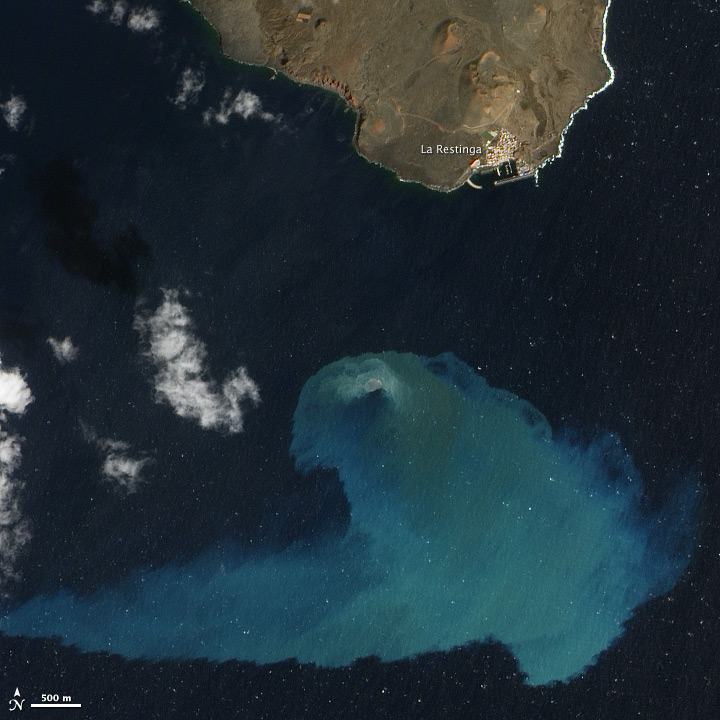Helium Gas Heralded Underwater Volcano Eruption


As the volcanic island of El Hierro, the smallest of Spain's Canary Islands, rumbled and groaned over the course of seven months in 2011 and 2012, gases silently percolated up through the island's soil and groundwater.
Eventually, a spectacular plume appeared off the southern coast of the island, a sign that El Hierro volcano, an underwater volcano just offshore, had finally erupted.
During that time, researchers had been busy collecting and analyzing the helium gas content of more than 8,000 soil and water samples. Now, those data can be used to monitor El Hierro and forecast its next eruption, researchers say, and likely other volcanic eruptions around the globe as well. [50 Amazing Volcano Facts]
"We believe that helium can anticipate the detection of magmatic movement even before those movements can be detected by seismic activity," said Eleazar Padrón, a geochemist at Spain's Technological Institute for the Renewable Energies, who led the work.
An almost ideal gas
Researchers have been using gas emissions to forecast volcanic eruptions for at least 30 years, but they usually focus on carbon dioxide, the second most abundant gas (after water vapor) in volcanic eruptions. Helium, a noble gas, is a better candidate for tracking and forecasting eruptions, Padrón explained, because it doesn't react with rocks or groundwater and microorganisms don't consume or produce helium.
"Because of these properties, helium has been considered by geochemists as an almost ideal geochemical indicator," he told OurAmazingPlanet.
Get the world’s most fascinating discoveries delivered straight to your inbox.
Padrón and his team found that measuring the flow of helium in El Hierro island's soil and water gave them clues as to when magma under the island was moving and how close it was to the surface — both important factors in forecasting a volcanic eruption.
The team also measured two helium isotopes — atoms of the same element with different numbers of neutrons. Helium-3, for example, has one neutron, whereas helium-4 has two. Helium-4 is produced when radioactive elements decay in the Earth's crust (its outermost layer), but helium-3, which accounts for the bulk of Earth's helium, is primarily found in the mantle (the hot layer between the crust and core).
Looking at the proportions of helium-3 and helium-4 in a gas sample, the researchers could determine how much helium had come straight from the mantle, and how much came from fresh breaks and fractures in the crust below El Hierro island. Fracturing crust is another clue that a volcanic eruption could be imminent.
The team's analyses show that, as the volcano began to stir, the crust fractured and helium, mostly from the mantle, flowed to the surface. As the actual eruption began, gas flow at the surface increased dramatically, and gas pressure beneath the island dropped. Then as seismic activity at El Hierro picked up again, the crust fractured and deformed extensively, and helium-4 became a larger component of the total helium released on the island.
A starting point
The system Padrón's team used to track helium at El Hierro may be a good example for researchers seeking to monitor other active volcanoes.
"This is a starting point for developing continuous monitoring stations of diffuse helium flux to strengthen the volcanic surveillance program at many volcanoes worldwide," Padrón said.
One reason this method proved important for forecasting activity at El Hierro volcano was that magma migrated to the surface aseismically — basically silently, without significant earthquakes to herald its arrival. The eruption could have taken residents by surprise if scientists hadn't been tuned into the island's increasing gas emissions.
Lagging technology will be the biggest challenge in setting up helium monitoring systems, Padrón said. To date, there's no instrument that can continuously quantify the type of diffuse helium fluxes seen at El Hierro.
The team's findings are detailed in the May issue of the journal Geology.
Follow OurAmazingPlanet @OAPlanet, Facebook and Google+. Original article at LiveScience's OurAmazingPlanet.


